
"The shipping lines had amassed a
great deal of wealth through the provision of reliable and increasingly
comfortable sea travel. This invested them with immense political and economic
power. The business of building ships is also one which requires utmost care and
attention to detail, given the disastrous consequences of ocean travel if a
collision took place......" From: Designing Liners - A
History of Interior Design Afloat by Annie Wealleans.
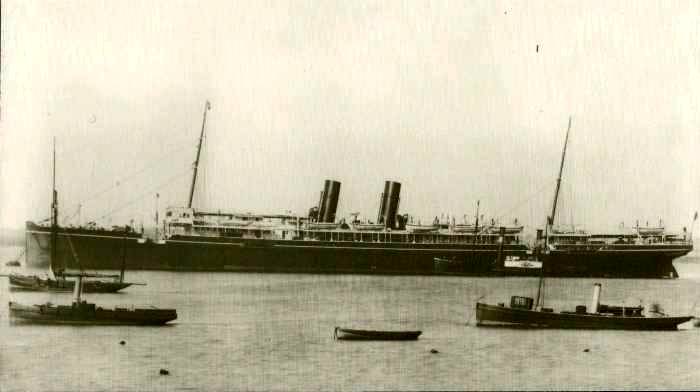
LOSS OF THE S.S. EGYPT - RELATIVES
WAIT FOR NEWS
London. 22nd May 1922.
'The courtyard of the P. and O.
offices in Leadenhall Street, London,
was the scene of a pathetic vigil today,
From early morning groups of relatives of
passengers and crew were
gathered waiting for news of the six
men, seven women, and two children
passengers members of the crew
not accounted for- among the survivors
who have reached Brest from the
wrecked liner Egypt. Eighty names
on the boat rollcall are unanswered,
of which 50 are of Lascars.
It is reported that 23 bodies have been
recovered. No news has at
present been received - from other ships
known to have been in the vicinity
regarding the picking up of possible
drifting survivors as was hoped. One vessel
was nine miles away at the time of the collision.
The survivors point out that the
great list the Egypt took immediately
after the impact made it most difficult
tor the passengers to approach the
lifeboats.
All three wireless operators perished.
The chief, operator, Mr Arthur Hardwick,
died at his post. He was at
dinner at the time of the collision. He
rushed up to the cabin ¡and told the
third operator to go to the boat deck
and help the officers,saying, '"I will
look after the wireless myself." When
the last boat had left the assistant
returned and spoke to Hardwick, but
he refused to leave his post. He continued
tapping out the S:O.S. He
was last seen standing at the door of
the wireless cabin as the vessel plunged
beneath the waves.
The steamers Lapland and Rotterdam,
arriving at Plymouth from New
York, were delayed by fog. They report
that they heard the S.O.S. 400
miles away.
Several of the biggest clothing stores
at Brest have been ransacked to provide
outfits for the rescued, some of whom
are most destitute. 'The
rescued pay tribute to the courage
and persistence of the French crew
of the steamer Seine and the lifeboats'
crews.
Two of the Egypt's . crew were injured
as a result of the impact.
The Egypt was a three decked
steamer, of a tonnage of 7,941. She
was built at Greenock in 1897 by
Messrs. Caird and Co. The vessel has
been running between India and England
for a number of years.
The cargo steamer Seine has a tonnage
of 1383. and was built by W.
Dobson and Co. at Newcastle in Ï899.'
From: The Australian Broken
Hill's Barrier Miner Newspaper, Tuesday 23rd May 1922
Note: The Egypt's
Commander, Captain A. Collyer, was suspended for six months, but resigned on a
full pension, after the Admiralty Court of Enquiry found the Seine was
responsible for the tragedy.
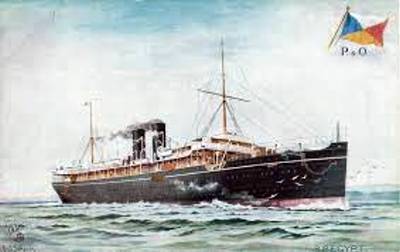
The ss EGYPT
~ Builders:
Caird & Company of Greenock,Yard No 285
Port of Registry: London
Engine: Steam triple expansion, 11,000 ihp. Trials Speed: 18.3 knots
Launched: Saturday, 15th May 1897
Tonnage: 7912 grt ~ Length: 499.8 feet ~ Breadth: 54.3 feet ~ Draught: 24.5 feet
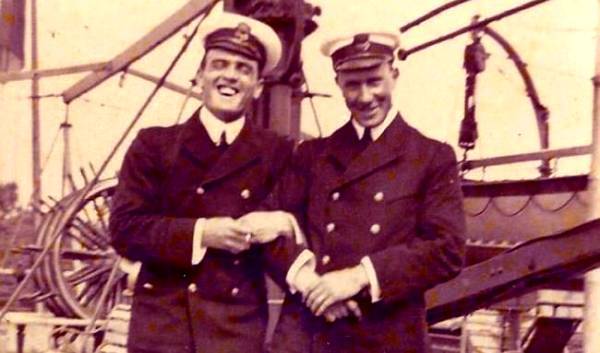
Captain Alexander Nicol Cameron
MBE, seen on the left in this photograph, served in the ss Egypt
as Senior 2nd Officer in 1921 - before her fatal collision. Leaving the P&O in
1922, to teach at Leith Nautical College, and shortly afterwards becoming
Principal of the Sir John Cass Nautical College in London. He was awarded
the MBE for his technical advice on the building and positioning of the Mulberry
Harbours in the Normandy landings of 1944, particularly on Gold, Juno and Sword
Beaches.
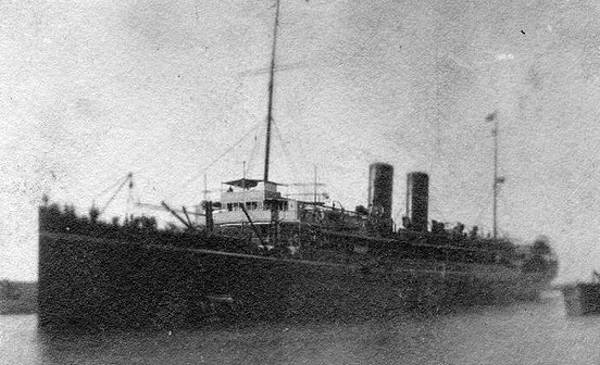
ss Egypt
in the Suez Canal
In September of
1897, the ss Egypt left London on her maiden voyage to Bombay, after which she
spent most of her early days on the Australian run.
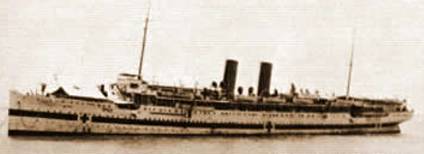
During 1910 while
on Eastern services she brought the Princess Royal home from Egypt, then
continued to cruise the Mediterranean up to the time of the Great War. Declared
as a Hospital Ship, she was repainted in white, marked with the international
Red Cross colours in August 1915, and converted to accommodate up to 461
patients. She saw service in the Dardanelles and continued in this role until
June 1919.
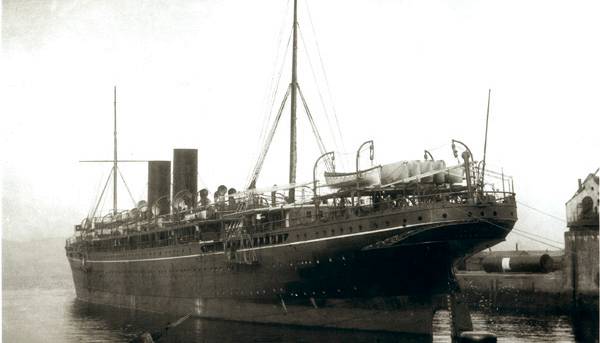
The P&O Steam
Navigation Company's ss Egypt was one of a class of five identical steamships:
India, China, Arabia and Persia. They each carried 320 passengers in First Class
and 160 in Second.
The Egypt left
Tilbury for Marseilles and Bombay on 19th May 1922, with 44 passengers and 294
crew on board, of whom 208 were Lascars and 'other Asiatics'. The majority
of her passengers were scheduled to join the ship at Marseilles, thereby
avoiding the worst of the North Atlantic weather, in particular the notorious
Bay of Biscay. In addition to her mails and general cargo, she carried a
consignment of gold and silver totalling £1,054,000 in value. On the evening of
the next day, in the neighbourhood of Ushant, she ran into thick fog and after
proceeding for some little time at reduced speed, Captain Collyer ordered 'stop
engine'. The sea was flat calm, and there was little or no wind. Visibility was
estimated at being no more than a mere thirty yards. Off Ushant the main traffic
routes run approximately 208 degrees to Cape Finisterre and 028 degrees
northbound. The sound of another steamship's whistle could be heard gradually
approaching - but the fog was too dense to locate her visually. Captain Collyer
decided that the approaching ship was on a reciprocal course to Egypt's. The
next blast of her whistle put her on his port beam - then she suddenly emerged
from the fog, going very fast, and within 15 seconds had struck Egypt on her
port side, between her twin funnels, with terrific force. She was the French
cargo steamer Seine, a ship
with strengthened bows, that
had been built to deal with Baltic ice. Momentum propelled her as she ripped
down the port side of the Egypt, tearing her open.
The fatally stricken Egypt at once
began to sink and a dreadful panic was reported to have ensued among the Lascar
seamen, who rushed the boats. All orderly methods of saving life went by the
board. The heavy list to port also created much greater difficulties for the
officers who were desperately striving to preserve some sort of order and
discipline. In spite of this, four undamaged boats were got away - but
within 20 minutes of the collision, the Egypt sank. Her list was so great that
just prior to her going, as many boats, rafts and deck fittings as possible were
cut loose, so that they might float free when the wreck submerged. By this
action the lives of many persons were saved. There are several instances of
individual heroism, such as that of an army officer who jumped into a boat and
forced its Lascar occupants to return to the ship's side, eventually getting 70
people away in safety. Meanwhile, the vessel which had done the damage, the
French steamship Seine, 1,383 tons, on passage from La Pallice to Le Havre, took
the survivors on board and conveyed them to Brest. Because of the thick fog, her
captain had left his more normal coastal route, standing well out to sea in
order to clear the busy traffic off Ushant. Twelve passengers and 84 crew
were lost with the ship, and one person later died in hospital. Captain Collyer
remained at his post to the last and was picked up in the water by one of the
boats. The position of the vessels at the time of the collision was about 20
miles off the Armen Lighthouse, the disaster occurring about 7 o'clock in the
evening. Lloyds of London paid the insurance claim in full.
With help from 'The Dictionary of Disasters At Sea', by Charles Hocking and
'These Splendid Ships', by David Divine.
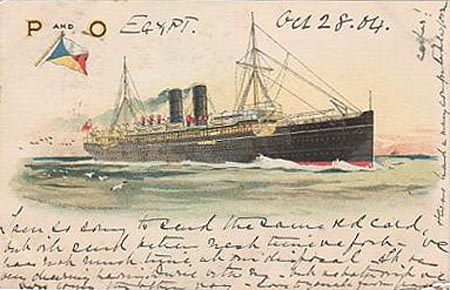
On
board, destined for the Government of India, were 1,089 gold bars, 1,229 silver
bars, 165,979 gold pound coins, - totalling around 5.5 tons of gold and 43 tons
of silver. The ship's cargo also included a large batch of banknotes of 5, 10
and 100 Rupee denominations, commissioned from the printers Waterlow & Son, by
the Nizam of Hyderabad.
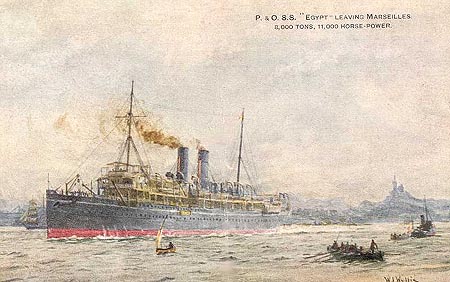
'It is
in the sequel that the Egypt achieved a strange, posthumous fame, for the
million pounds of gold in her mail room became the prize of one of the greatest
stories of salvage in the history of the sea.'
David Divine, 'These
Splendid Ships'.
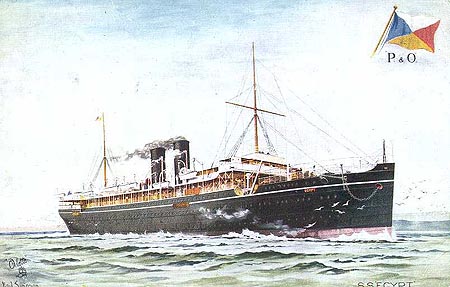
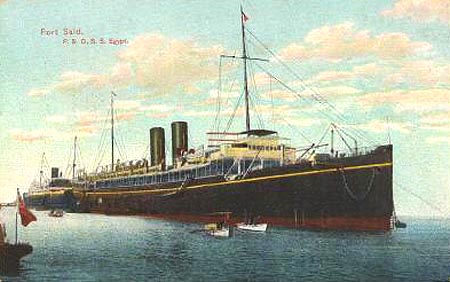
Salvage..
Note; The
Times journalist David Scott covers this incredible story of salvage in
detail with in two rare 1931/2 books 'Seventy Fathoms Deep' and 'The Egypt's
Gold'.
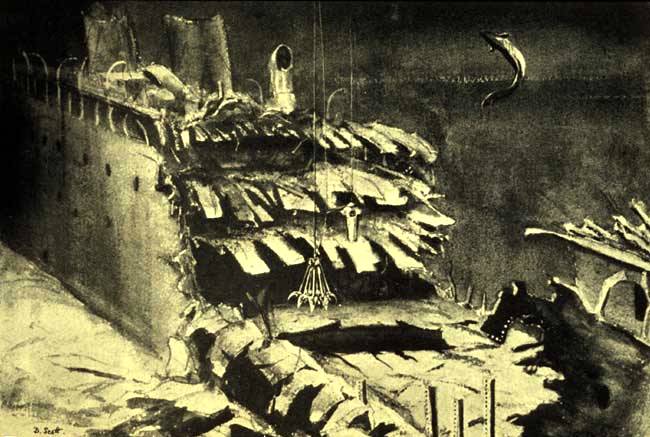
David Scott's impression of
how the wreck would have looked during the salvage operation of 1932.
The task of recovering the specie
lost in the liner marked a new era in the science of undersea salvage. The work
was taken in hand as soon as possible, but not without misgiving, for the vessel
had sunk in 60 fathoms of water, a depth beyond that at which diving operations
could normally be carried on. From 1923 to 1928 various companies conducted a
search for the wreck, but without success. In 1925, Mr Peter Sandberg, of the
London firm of Sandberg and Swinburne, conceived the idea of recovering the gold
with an elaborate apparatus he called 'The Eye' - an electrically powered
submersible observation chamber, fitted with rudimentary external manipulator
arms. A contract was negotiated with the Salvage Association of London, and
M.Allain Terme, a Frenchman, was employed to carry out the work - but was then
superseded by the Italian Sorima Company of Genoa, with their Neufeldt and
Kuhnke 'diving shell' and cylindrical observation chamber, which had proved
successful during trials in the Mediterranean.
A contract was
awarded to Sorima in 1928, and in June, 1929, the Italian Society for Marine
Recovery, directed by Commendatore Giovanni Quaglia, took up the search, with
their salvage vessel, the ss Artiglio.
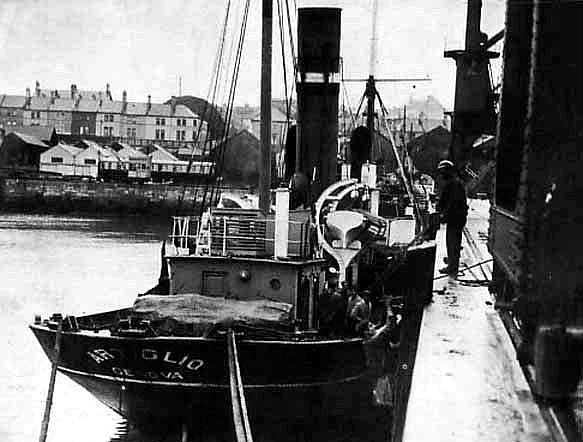
The
Italian salvage vessel Artiglio
After many
disappointments, extending over 15 months ,the wreck was located at a depth of
360 feet, by means of drag lines. The Egypt was lying on an even keel, with
masts and funnels still standing, and on a smooth sea bed.
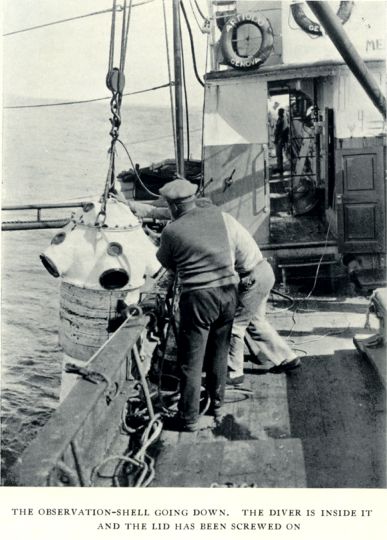
The patent diving
machine carried on board the Italian salvage ship, Artiglio, enabled a diver to
descend to this great depth in perfect safety and later to recover nearly all
the specie. Blasting operations opened up a way into the ship's hull through
which the treasure was eventually extracted.
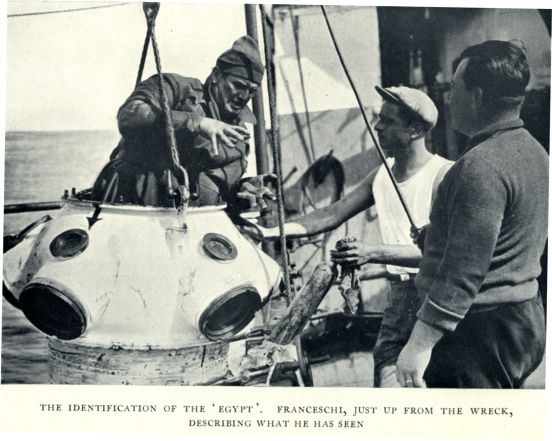
The cost of the salvage from first to last to the Italian company alone was
£200,000, but a great task had been achieved and much valuable experience of
deep sea diving had been gained. An idea of the immensity of the work may be
realised from the fact that it did not finally conclude until 1933, or nearly
five years after it commenced. Taking into account the fruitless years of search
by the French and Swedish companies from 1923 onwards, quite ten years had been
spent on salving the Egypt's valuable cargo.
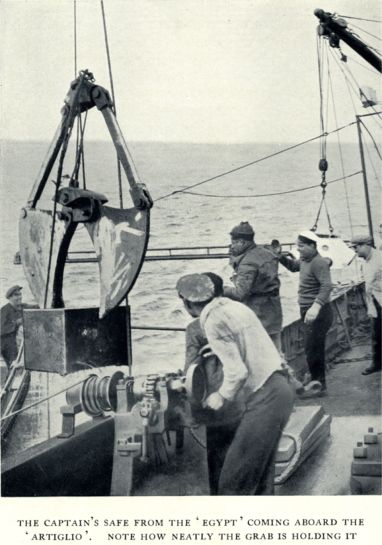
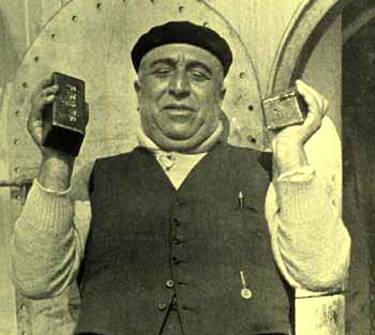
The irrepressible
Giovani Qaglia with two gold bars from the Egypt.
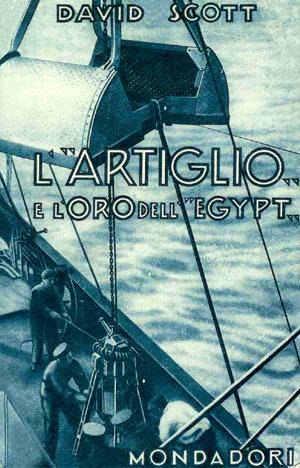
It is said that 14,929
sovereigns, 17 gold bars and 30 silver ingots are still unaccounted for......
http://www.deepimage.co.uk/wrecks/egypt/egypt_mainpages/egypt_mainpage.htm
Additional information about the history of the Salvage Ship Artiglio can be
found at the Artiglio foundation:
http://www.premioartiglio.it/
Back to the ship - and her beautiful interiors....
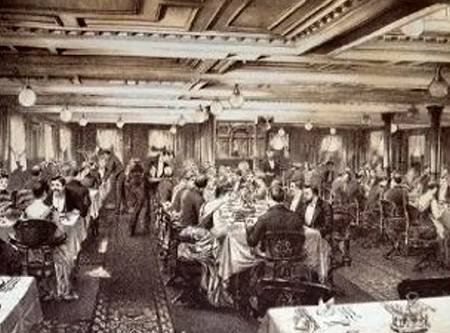
The first
class dining saloon aboard the ss Egypt
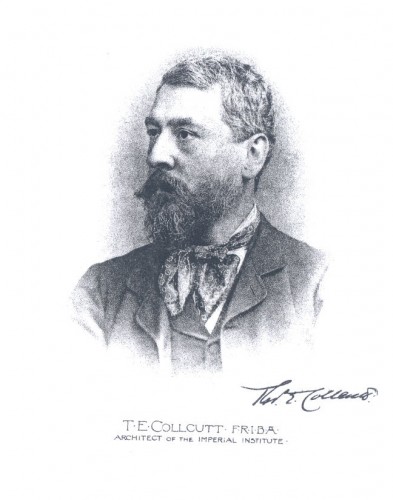
Thomas Edward Collcutt,
an architect of the Arts and Crafts Movement, was born in Oxford
on 16th March 1840 and devoted a lifetime to creating buildings
and interiors that were widely recognised for their richness in style, finishes and
furnishings.
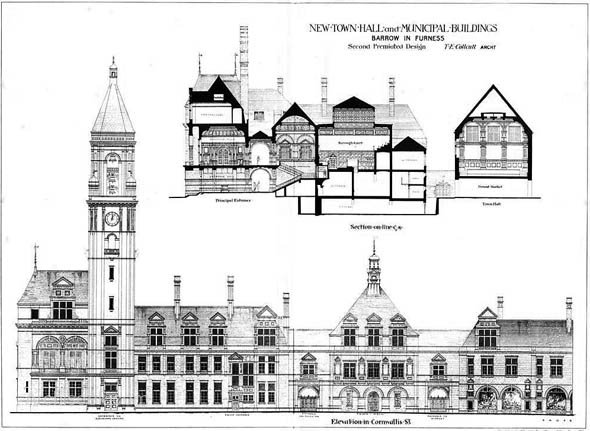
Buildings such as Lloyds Register in Fenchurch Street, London's Savoy Hotel,
the Imperial Institute, the Midland Bank on Ludgate Hill, the Public Library in Blackburn,
Wakefield Town Hall, the Town Hall & Municipal Buildings at Barrow-in-Furness and many others.
Originally apprenticed to George Edmund Street, a
leading practitioner of
the
Victorian Gothic revival,
Thomas Colcutt set up his own practice in 1873, and designed ebonized pieces for
Collinson and Lock, one
of the foremost producers of Aesthetic and Art Nouveau furniture in London
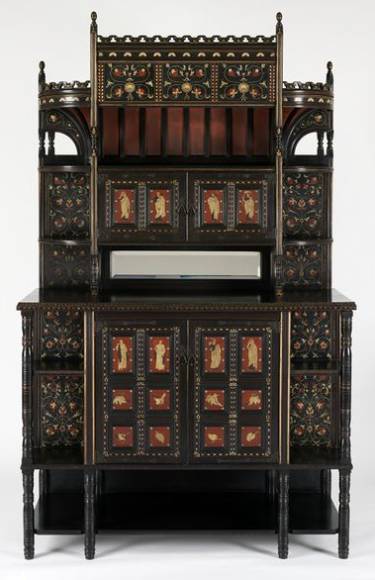
A
cabinet made by T E Collcutt in 1871, in mahogany, ebonised and painted,
with metal fittings. Now in the V&A, London
He was one of
the first artists to be asked to help in a worthier treatment of the
interior decoration of passenger ships of the major steamship companies, and
in this capacity he dealt with a considerable number of P&O steamships.
His interiors soon became the fashion for many first class music rooms, dining areas
and lounges in the Company's ships throughout the late 1890’s and early 1900s,
among them the India, China, Egypt, and the Medina in 1911. By the
1880's, steamships had become a popular and luxurious way to travel, and P&O
employed specialist architects and designers to create a sense of sumptuousness
and style aboard their more prestigious ships. In total, Thomas Colcutt
completed 12 interiors for P&O, from 1896 to 1903.
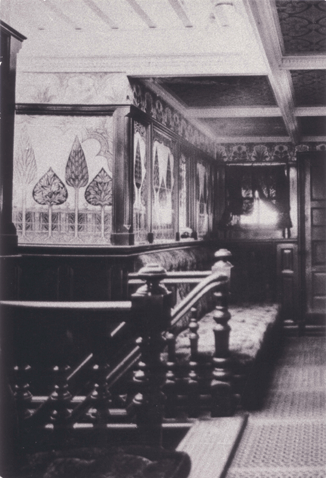
A companionway
aboard the ss Arabia, the Egypt's sister-ship, designed by T E Calcutt, with
tiles by De Morgan.
Between 1882 and
1900, De Morgan designed schemes and produced tiles for twelve P&O liners.
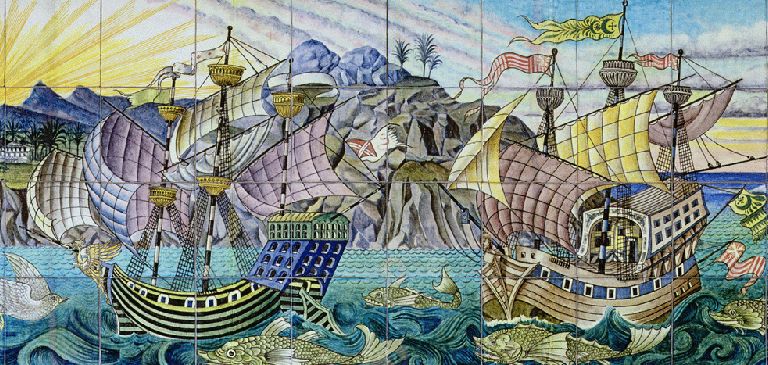
The De Morgan Centre purchased this spectacular galleon panel at auction on
the 4th October 2006 (Sotheby’s Lot No.6) with the generous
assistance of
The Heritage
Lottery Fund,
The Art Fund and Mr John
Scott. Measuring 2ft by 5ft, the panel consist of 40, 6 inch square tiles and
represents a colourful and exotic scene of sailing ships, birds and sea
creatures - all favourite De Morgan motifs. The
design of the galleon panel was originally created for De Morgan’s commissions
with
P&O, and was
installed aboard the
ss
Malta by her builders Caird and
Co in 1895.
It
comes as no surprise that the leading designers and craftspeople of the day were
commissioned to provide decoration for these luxurious ‘homes from homes’.
Thomas Collcutt commissioned De Morgan and Company to produce
tiles for P&O steamships, including the Sutlej (1882),Britannia
(1887), Oceana (1888),
Nubia (1895), Malta (1895),
Sumatra (1895),
China (1896)
India (1896), Egypt
(1897)
Arabia (1898)
and Persia (1900).
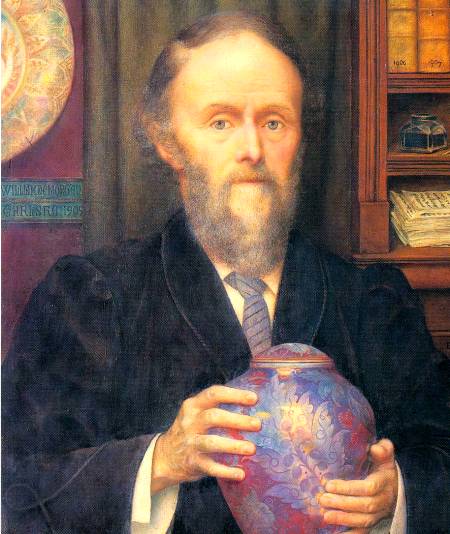
William De
Morgan
William De Morgan
(1839 – 1917) was one of the greatest ceramicists of his age and his brilliant
lustre-ware pots and decorative tiles are still much in demand by collectors.
His rediscovery of lustre was a significant technical contribution to the
decorative arts of the nineteenth century.
The success of the P&O contract,
over which the P&O board kept tight control over the look
and quality of the interiors of their liners, contributed greatly to the
reputation of De Morgan. His schemes were repeated, with only slight variation in several ships.
His
designs included wall panels of repeat floral patterns such as Arabia and India
friezes, which he designed specifically for their namesake ships. He also
designed many panels which portrayed evocative landmarks on the ship's ports of
call.
Note:
Three other large tile panels on display at the De
Morgan Centre (on loan from the South London
Gallery) are also thought to be designed for P&O
liners - although it is not clear for which. These
three are comparable in scale and in construction
techniques to the Galleon panel, and are
again typical of the atmospheric schemes chosen by
De Morgan. One shows an Islamic city with a mosque
set between two minarets, another depicts a fanciful
Italianate fountain with dolphins spouting water
into a vast marble urn, and the third, another
fountain scene set against a classical Italianate
city.
In addition to De Morgan and Company’s
work for P&O, he also designed schemes for
several other ships and yachts - perhaps most notable of all for the
Royal Steam Yacht Livadia -
designed for
Czar Alexander II of Russia.
The
De Morgan Centre is at 38 West Hill, London
SW18 1RX .
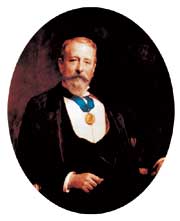
Thomas E. Colcutt
Thomas Colcott's
interior design for the five ships of the
Egypt class followed the same basic layout,
which emulated the deck plan of the Oceanic,
with six decks in total. The first to be
launched, the SS India, was built by Caird &
Co. of Greenock and was 7,911 gross tons,
over 3,000 more than the Kaiser-i-Hind. It
was 500 feet in length and 54 feet in width,
and could accommodate 314 passengers in
first saloon class and 212 in second. The
first class passengers were situated
amidships, and the second class
accommodation was placed towards the front
of the ship. The interiors were decorated to
Collcutt's designs by a specialist firm; in
the case of the Egypt it was George Jackson
Ltd, with the shipbuilders' Caird & Co.'s
carpenters. The first class dining room of
the Egypt was in fashionable taste and bears
striking similarity to London's Holborn
Restaurant.
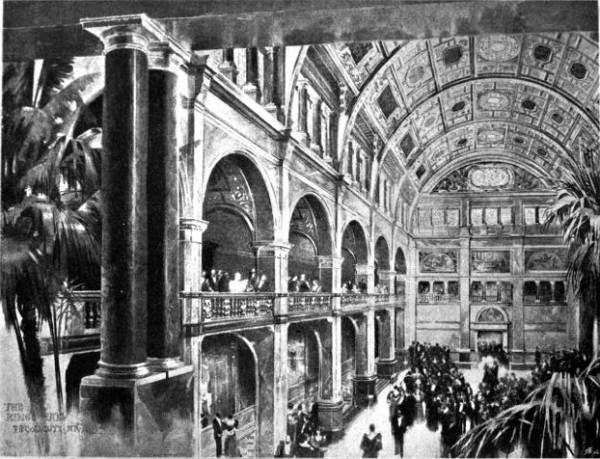
The King's Hall,
Holborn Restaurant. by Thomas E.
Colcutt (1895). Source:
Academy Architecture and Sculpture.
It
was furnished with mahogany furniture with
long tables and carpet runners, to ease
floor cleaning. The dining chairs had solid,
carved wooden backs and arms with
decorative, patterned squab. The chairs were
also fixed to the floor to avoid movement
during rough weather, but rotated around for
passenger convenience. The pattern on the
textiles was reflected in the swirling,
decorative plasterwork on the ceiling and
the walls were panelled in wood to dado rail
height by the shipbuilders, with decorative
plasterwork friezes above by Jacksons. The
room was lit on either side by windows,
dressed with plain, dark curtains. The
overall colour scheme was white and gold for
the wood and plasterwork. Despite the colour
scheme, designed to create a feeling of
spaciousness, the room appeared cramped,
given the low ceiling height, the
punctuation of the space by a central row of
columns and the heavy decoration on the
ceiling and beams, The second class dining
room was similar in style, only the
plasterwork decoration on the walls was
replaced by Tynecastle tapestry panels.
Tynecastle tapestry was a heavy wallpaper,
produced by the firm of Scott Morgan, which
was cheaper than Jackson’s alternative of
plasterwork.
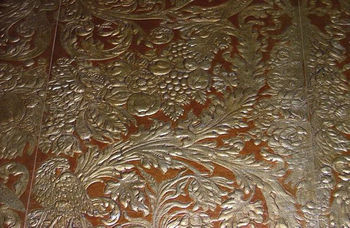
An imitation leather paper, c1890, embossed
with metal foil.
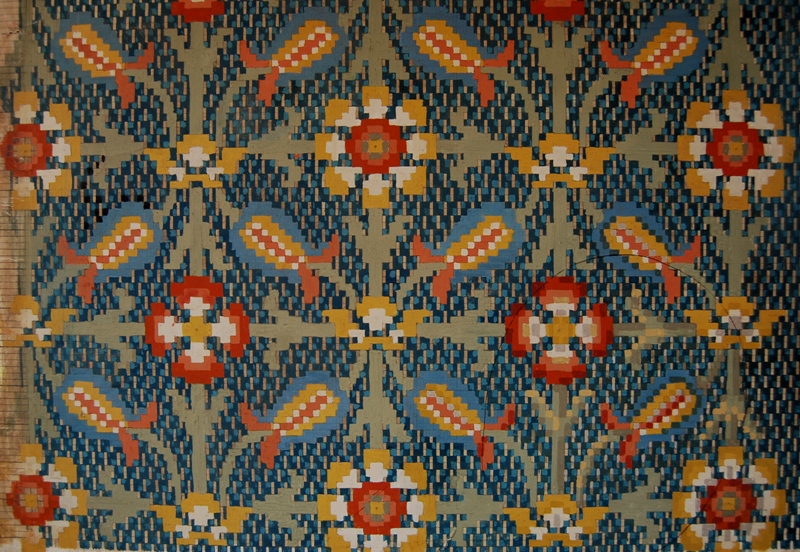
Tynecastle Tapestry wallpaper design by
William Scott Morton
Both the Egypt and Arabia had a hurricane
deck above the first class dining room and
the first class lounge/music room, which
enables a stained glass skylight to add more
illumination and decoration. The
lounge/music room had a capacious bookshelf
running along one wall and the woodwork was
African mahogany with ceiling decoration
again by Jacksons. There were built-in
sofas, freestanding sumptuous armchairs and
a piano stool upholstered in heavily
patterned moquette with heavily patterned
carpet to match. Collcutt subcontracted a
range of decorative tiles from the up market
Arts and Crafts ceramicist. William Frend De
Morgan (1839 1917). De Morgan tiles were
more expensive than the mass produced,
transfer printed variety, but Collcutt
obviously thought the extra cost was worth
it for the added kudos and quality of
appearance (Catleugh 1983: 114). He used
lustreware to create a shimmering surface
for the tiles, derived from Italian majolica
and Hispano-Moresque examples. His colour
range was distinctive and inspired by that
of fifteenth- and sixteenth-century Isnik
ware, or Persian ware as De Morgan called
it. This consisted of dark blue, turquoise,
manganese purple, green, Indian red and
lemon yellow. This formal inspiration,
coupled with the depiction of near Eastern
scenes in ceramic made De Morgan's work a
perfect match for P&O ships, destined for
the East in the service of the British
Empire- an appropriation of Eastern
decorative styles to decorate vehicles of
Western modernity. It is worth stressing
that the tiles were used for passageways and
smoking rooms, not first class sitting rooms
or saloons, which were decorated in
historicist Western styles.
By
this date De Morgan had undertaken some
prestigious commissions, including the
supply of Islamic tiles for the Arab Hall at
Leighton House for the Victorian painter, Frederick (later Lord) Leighton, and
supplied panels of tiles for the Czar of
Russia's yacht, Livadia. He
had supplied tiles for other P&O ships
before Collcutt's commissions, possibly due
to the publicity which the Czar s luxury
vacht attracted: the Sutlej (1882):
Britannia (1887); Oceana (1888); Nubia
(1895) Malta (1895); Palawam (1895) and
Sumatra (1895) The tiling provided cool and
robust wall decoration, essential for the
tropical heat and able to withstand the wear and
tear of passenger use, while ensuring
cleanable surfaces for areas such as the
smoking saloon. For companionways on the
India, De Morgan provided two 11 by 32"
panels and 88 9" frieze tiles. The smoking
saloon, situated on the hurricane deck aft
was decorated by De Morgan tiles in panels
of 41" by 32"and 42" by 32", drawn from
designs already used on the Sumatra and Palawam. Described by The Glasgow Herald as:
'The first-saloon smoking room is perhaps the
prettiest room in the vessel It is fitted up
with oak panels, stained green, and art
decoration in the shape of handsome
seascapes and landscapes are placed all
around' (14.10.1896). De Morgan's tilework
provided a utilitarian and fittingly exotic
decoration for the walls of the public
spaces. However, De Morgan found the
experience of working with P&O to be very
different from the client designer
relationship he was accustomed to for land
based design. He wrote to his business
partner Halsey Ricardo. describing the P&O
Chairman and Board as:.. 'a highly meddlesome
pragmatic body' (18.2.1895). No records can
be traced of P&O's opinion of De Morgan, but
the system whereby the commissioning
architect responsible for the interior
design of the ship would present design
ideas to the board in great detail for
approval, was a pattern which characterised
the interior design of ships from this
period and throughout the following century.
This
is a work in progress - if you have
photographs or editorial regarding the
Egypt,
I would love
to hear from you!































